| Home |
| Acknowledgments |
| Conventions |
| Glossary |
| Maps |
| References |
| Links |
| Articles |
| Thumbnails |
| Species
list |
| Family |
| Next
species |
Additional Photos
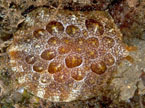
light

dark

side & shrimp

front
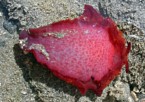
underside

young, 2.5 mm
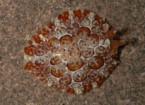
young, 15 mm

gill
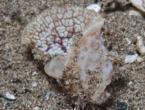
burrowing

fecal material

shell
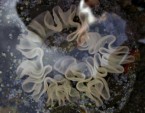
probable egg mass
_______________
GALLERY

Pleurobranchus forskalii (Ruppell & Leuckart, 1828)
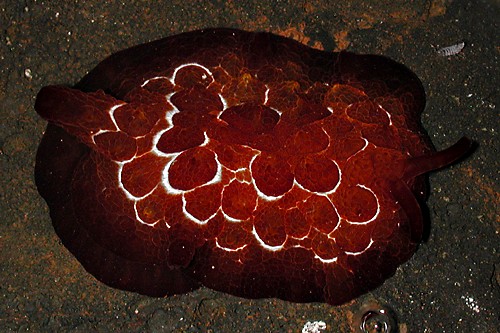
| Maximum size: about 200 mm
(Hoover, 2006). Identification: The notum of this species is covered with broad, rounded compound tubercles. The color is highly variable ranging from light golden-brown with extensive white pigment to dark violet-brown (usually with white arcs outlining the tubercles). In contrast, light animals often have dark arcs outlining the tubercles and white pigment concentrated on their dorsal faces. The underside of the foot is spotted with dark pigment and the rhinophores of juveniles are tipped in white. Its shell lacks radiating striae. Natural history: Pleurobranchus forskalii is a moderately common nocturnal species. It can occasionally be found in tide pools at moderately exposed rocky sites but is more frequently seen in Halimeda kanaloana beds at depths of 9-10 m (30-33 ft). It may also occur in shallow, protected sandy habitats at depths of as little as 1 m (3 ft). It usually carries the posterior portion of its mantle in a siphon-like fold and may bury itself in sand during the day. (Note 1) It probably feeds on colonial tunicates. (Note 2) It lays a large, cream, spiral egg mass with a ruffled margin. Distribution: Big Island, Maui and Oahu: widely distributed in the Indo-Pacific. Taxonomic notes: It was first recorded in Hawaii from Hale'iwa Harbor, Oahu by Darrell Takaoka; circa 1997. It's referred to as "Forsskal's pleurobranch" in Hoover, 1998 & 2006. Photo: CP: dark: Napili Bay, Maui; April 21, 2005. Observations and comments: Note 1: Ralph Turre photographed an animal buried in sand except for a funnel-shaped fold of the foot margin. (see photo) Perhaps, the exposed fold channels water over the gill of the buried animal? During the 2017 MarineGeo at Kaneohe Bay, Oahu a mature animal was found resting in a shallow sand patch with the notum lightly covered with sand. Note 2: On March 14, 2014 a 22 mm animal produced three strings of fecal material while held in a dish. The material appeared to be largely composed of "compressed" remnants of a white didemnid tunicate that is common in the habitat where it was found (suggesting that it eats that species). (see photo) |
| Thumbnails |
Species
list |
Family | Next species | Top |